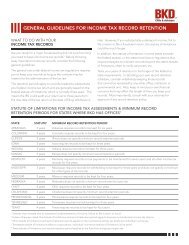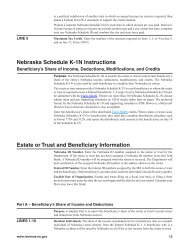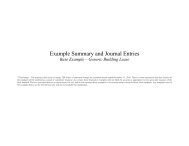acfe fraud prevention check-up - BKD
acfe fraud prevention check-up - BKD
acfe fraud prevention check-up - BKD
- No tags were found...
You also want an ePaper? Increase the reach of your titles
YUMPU automatically turns print PDFs into web optimized ePapers that Google loves.
Organizations can identify and assess <strong>fraud</strong> risks in conjunction with an overall enterprise risk assessment oron a stand-alone basis.Guidance for conducting a <strong>fraud</strong> risk assessment is provided in this section of the guide. Organizations can tailor thisapproach to meet their individual needs, complexities, and goals.The foundation of an effective <strong>fraud</strong> risk management program should be seen as a component of a largerenterprise risk management (ERM) effort and is rooted in a risk assessment that identifies where <strong>fraud</strong> may occurand who the perpetrators might be. To this end, control activities should always consider both the <strong>fraud</strong> scheme andthe individuals within and outside the organization who could be the perpetrators of each scheme. If the schemeis collusive 29 , preventive controls should be augmented by detective controls, as collusion negates the controleffectiveness of segregation of duties.Fraud, by definition, entails intentional misconduct, designed to evade detection. As such, the <strong>fraud</strong> risk assessmentteam should engage in strategic reasoning to anticipate the behavior of a potential <strong>fraud</strong> perpetrator. 30 Strategicreasoning, which is also important in designing <strong>fraud</strong> detection procedures that a perpetrator may not expect,requires a skeptical mindset and involves asking questions such as:• How might a <strong>fraud</strong> perpetrator exploit weaknesses in the system of controls?• How could a perpetrator override or circumvent controls?• What could a perpetrator do to conceal the <strong>fraud</strong>?With this in mind, a <strong>fraud</strong> risk assessment generally includes three key elements:• Identify inherent <strong>fraud</strong> risk 31 — Gather information to obtain the population of <strong>fraud</strong> risks that couldapply to the organization. Included in this process is the explicit consideration of all types of <strong>fraud</strong> schemesand scenarios; incentives, pressures, and opportunities to commit <strong>fraud</strong>; and IT <strong>fraud</strong> risksspecific to the organization.• Assess likelihood and significance of inherent <strong>fraud</strong> risk — Assess the relative likelihood and potentialsignificance of identified <strong>fraud</strong> risks based on historical information, known <strong>fraud</strong> schemes, and interviewswith staff, including business process owners.• Respond to reasonably likely and significant inherent and residual <strong>fraud</strong> risks — Decide what the responseshould be to address the identified risks and perform a cost-benefit analysis of <strong>fraud</strong> risks over which theorganization wants to implement controls or specific <strong>fraud</strong> detection procedures.29A collusive scheme is one performed by two or more individuals working together.30T. Jeffrey Wilks and M.F. Zimbelman, “Using Game Theory and Strategic Reasoning Concepts to Prevent and Detect Fraud,” AccountingHorizons, Volume 18, No. 3 (September 2004).31The initial assessment of <strong>fraud</strong> risk should consider the inherent risk of particular <strong>fraud</strong>s occurring in the absence of internal controls. Afterall relevant <strong>fraud</strong> risks have been identified, internal controls are mapped to the identified risks. Fraud risks that remain unaddressed byappropriate controls comprise the population of residual <strong>fraud</strong> risks.20









